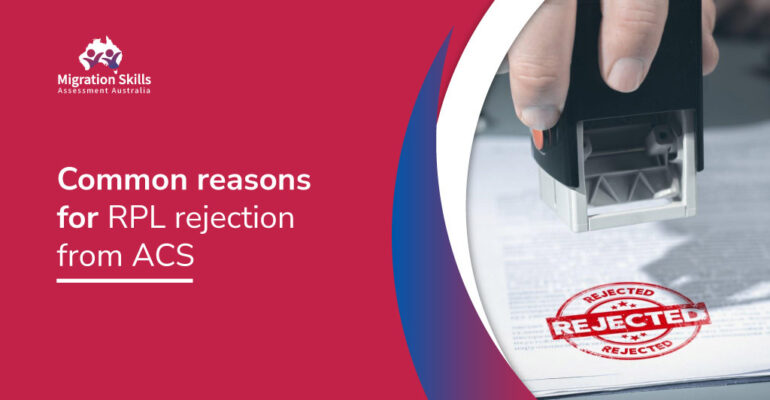Common reasons for RPL rejection from ACS

Common reasons for RPL rejection from ACS
Recognition of Prior Learning (RPL) is a valuable pathway for professionals seeking skills assessment by the Australian Computer Society (ACS). With RPL, individuals can leverage their relevant work experience, qualifications, and achievements to gain recognition for their skills and qualifications, even if they lack formal education in the field. It allows experienced professionals to showcase their capabilities and receive recognition within the Australian job market.
However, while RPL offers an alternative route to demonstrate competence, it is essential to understand that the ACS RPL report has specific guidelines and criteria for assessing RPL applications. Many applicants need help with having their RPL submissions rejected, often due to common pitfalls that could get avoided with proper preparation and understanding.
This comprehensive blog will delve into the common reasons for RPL rejection from the ACS and provide valuable insights to help applicants navigate the assessment process successfully. Getting familiarized with these potential stumbling blocks and incorporating the suggested strategies can enhance the chances of a positive assessment outcome.
Six Common Reasons for RPL Rejection from ACS
Understanding the common reasons for RPL rejection is crucial for applicants to avoid these pitfalls and increase their chances of a successful assessment outcome. Here are some of the most common reasons why RPL applications may get rejected:

1. Insufficient Evidence
One of the primary reasons for RPL rejection is the need for sufficient evidence to support the claimed skills and qualifications. The ACS requires applicants to provide comprehensive documentation, such as reference letters, work samples, project reports, and certificates.
Insufficient evidence or poorly presented documentation can lead to RPL rejection. To avoid this, it is crucial to carefully read and understand the ACS guidelines and ensure that all necessary documents get provided clearly and concisely. Providing specific and detailed examples of work and achievements will significantly strengthen the RPL application. When preparing an RPL application, consider the following tips:
- Identify the projects that get worked on, roles and responsibilities, and the technologies utilized.
- Provide evidence of achievements, such as successful project completions, process improvements, or cost savings.
- Include relevant work samples or excerpts to demonstrate technical skills.
- Request reference letters from supervisors or colleagues who can validate experience and skills.
Presenting a robust collection of evidence can enhance the credibility of the RPL application.
2. Irrelevant or Outdated Experience
Another common reason for RPL rejection is when applicants submit experiences deemed irrelevant or outdated by the ACS. It is crucial to align work experience with the nominated occupation or skills category for which you seek an assessment. Ensure that the tasks, responsibilities, and achievements mentioned in the application are directly related to the relevant ANZSCO code.
Additionally, ACS assessors expect recent experience within the past ten years to evaluate an applicant’s current knowledge and skills. If experience falls outside this timeframe, it may be considered outdated, and the application could get rejected. To avoid this, consider the following:
- Review the ANZSCO code and occupation description carefully to understand the required skills and knowledge.
- Assess whether work experience aligns with the identified occupation.
- Highlight recent projects or assignments to demonstrate current expertise in the field.
- If experience is older than ten years, try to bridge the gap by providing evidence of continuous professional development, certifications, or recent relevant work.
Ensuring that experience is relevant and recent can strengthen RPL application.
Read more: Top 10 reasons why Engineers migrate to Australia 📑📑
3. Lack of Depth and Breadth
The ACS assessors seek evidence of both depth and breadth in the claimed skills and qualifications. Depth refers to the applicant’s ability to understand the field through in-depth technical knowledge and experience comprehensively. Breadth, on the other hand, pertains to the variety and range of skills and expertise across different areas within the nominated occupation.
RPL applications that lack depth and breadth result in RPL rejection. Therefore, it is crucial to provide detailed information about roles, responsibilities, projects, and the technologies they have worked with to showcase expertise in the relevant field. To address this, consider the following:
- Clearly outline the scope of work and the technical complexities encountered.
- Demonstrate ability to apply theoretical knowledge to practical situations.
- Provide evidence of involvement in different stages of projects, from initiation to implementation and monitoring.
- Showcase experience with various technologies, methodologies, or tools related to the nominated occupation.
Showcasing the depth and breadth of the RPL application can impress the Australian Computer Society (ACS) assessors and increase the likelihood of a successful assessment.
4. Failure to Meet Key Areas of Knowledge
The ACS has defined a set of Key Areas of Knowledge (KAoK) for each ANZSCO code. These KAoK outline the core competencies required for a particular occupation. Failing to address these KAoK adequately is a common reason for RPL rejection.
It is essential to carefully review the KAoK for the nominated occupation and provide detailed evidence of skills and knowledge in each area. Align work experience, qualifications, and achievements with the KAoK to demonstrate proficiency in the required areas. Consider the following steps:
- Study the KAoK for the nominated occupation thoroughly.
- Assess knowledge and skills in each area and identify any gaps.
- Provide specific examples and evidence of expertise in each KAoK area.
- If you need more experience or formal qualifications in a particular KAoK area, consider undertaking relevant courses or certifications to strengthen your application.
Ensuring that the RPL application comprehensively addresses the Key Areas of Knowledge can increase the chances of a positive assessment.
Read more: Documents checklist for ACS Skills Assessment 📑📑
5. Plagiarism and Misrepresentation
Plagiarism and misrepresentation are serious offenses and can lead to immediate RPL rejection. The ACS has sophisticated plagiarism detection mechanisms, and any dishonesty will result in severe consequences.
Ensuring all information provided in the application is accurate, authentic, and properly referenced is crucial. Avoid using templates or copying content from other sources without appropriate citation. Present work and achievements genuinely and transparently. To avoid plagiarism and misrepresentation, consider the following:
- Clearly distinguish work from external sources.
- Provide proper references for any information or resources used in an application.
- Use appropriate words to describe experience, achievements, and skills.
- Seek assistance from professional editors or proofreaders to ensure the application is free from any unintentional plagiarism.
Maintaining integrity and authenticity in the RPL application can establish trust with the ACS assessors and increase the chances of a successful assessment.
6. Inadequate English Language Proficiency
Proficiency in the English language is essential for successful RPL assessment. Poorly written documentation, grammatical errors, and inadequate language skills can lead to RPL rejection. The ACS assessors expect clear and concise communication in the application.
It is advisable to seek professional assistance, proofreading, and editing services to ensure documentation is error-free and meets the required language standards. To improve English language proficiency in RPL application, consider the following:
- Use clear and concise language to convey ideas.
- Pay attention to grammar, punctuation, and spelling.
- Seek assistance from native English speakers or language experts for feedback and suggestions.
- Take English language proficiency tests, such as IELTS or PTE, to demonstrate language skills.
Presenting a well-written and error-free RPL application can showcase professionalism and enhance the chances of a positive assessment.
Read more: Four ACS RPL assessment pathway for Skilled Migration 📑📑
General Tips for Writing an RPL Application
Writing an RPL application that meets the requirements and stands out to the assessing authority is crucial for a successful outcome. Here are some tips to help you write your RPL application appropriately:
- Carefully read and understand the assessment authority’s guidelines, like the Australian Computer Society. Familiarize yourself with the specific requirements, documentation, and assessment criteria to ensure your application meets all the necessary guidelines.
- Gather comprehensive evidence of your skills, knowledge, and experience. Include reference letters, work samples, project reports, certifications, and other relevant documents demonstrating your competence in the nominated occupation. Provide specific examples and quantify your achievements wherever possible.
- Ensure that your work experience aligns with the requirements of the nominated occupation. Review the occupation description and identify the critical skills, tasks, and responsibilities expected in that field. Highlight your experience and achievements that directly relate to those requirements.
- Pay special attention to the Key Areas of Knowledge (KAoK) specified by the assessing authority. Demonstrate your proficiency in each area by providing detailed examples and evidence of your knowledge and skills. Clearly articulate how your experience and qualifications align with the KAoK.
- Use clear and concise language to convey or communicate your ideas effectively. Avoid technical jargon or excessive use of acronyms that may confuse the assessors. Clearly explain complex concepts and use simple, straightforward language to ensure clarity.
- Thoroughly proofread your application to eliminate any grammatical errors, spelling mistakes, or typos. Pay attention to punctuation and sentence structure. Consider seeking assistance from professional proofreaders or editors to ensure the application is error-free.
- Consider seeking professional assistance if you need more clarification on any application process. Professional writers, editors, or RPL consultants can provide valuable guidance, review your application, and help you effectively present your skills and experience.
- Pay attention to the language proficiency requirements specified by the assessing authority. Use proper grammar, punctuation, and spelling. If English is not your first language, consider taking language proficiency tests such as IELTS or PTE to demonstrate your language skills.
By following these tips and ensuring that your RPL application is comprehensive, aligned with the guidelines, well-written, and authentic, you can increase your chances of a successful assessment outcome.
How can MigrationSkillsAustralia help?
MigrationSkillsAustralia allows individuals to showcase their relevant work experience and qualifications, even if they lack formal education. By carefully preparing the required documentation, aligning experience with the nominated occupation, demonstrating proficiency in the relevant KAoK, maintaining authenticity and transparency, and ensuring strong English language skills, applicants can significantly enhance their RPL applications.
It is crucial to emphasize the importance of thorough research, attention to detail, and adherence to the ACS guidelines throughout the application process. Seeking professional guidance and assistance, such as engaging proofreading and editing services, can also significantly improve the quality and effectiveness of the RPL submission.
Read more: Engineering Jobs in Australia 📑📑
Conclusion
Submitting an RPL application to the ACS can be daunting, and the possibility of rejection is a genuine concern. However, applicants can significantly improve their chances of a successful outcome by understanding and addressing the common reasons for RPL rejection discussed in this comprehensive guide.
Remember to provide complete and relevant evidence, align experience with the KAoK, maintain authenticity and transparency, and demonstrate strong English language skills. Following these guidelines can enhance RPL application and increase the likelihood of achieving a positive assessment from the ACS.

 WhatsApp Quick Contact
WhatsApp Quick Contact

 WhatsApp Quick Contact
WhatsApp Quick Contact
